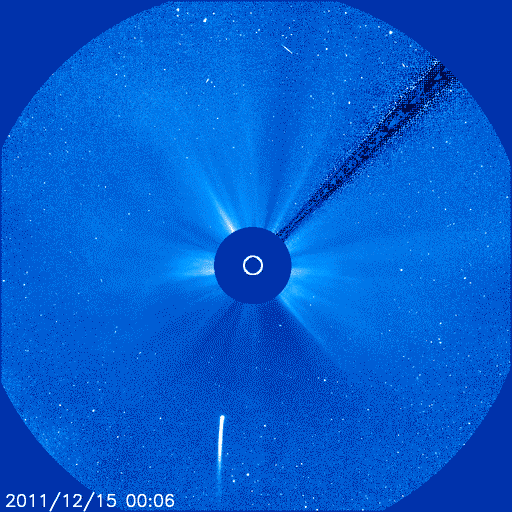UPDATE, 16 DECEMBER
Contrary to expectations, Comet Lovejoy actually managed to survive its close encounter with the Sun, passing by unharmed… as this startling video shows.

An animation made using images from SOHO's Large Angle Spectrometric Chronograph (LASCO), reveals the comet heading towards the Sun – on course for destruction
Credit: SOHO/LASCO (ESA/NASA)
Comet Lovejoy, first spotted on 27November by Australian astronomer Terry Lovejoy, is thought likely to meet its end at midnight tonight (00:00 UT, 16 December) as its orbital trajectory takes it too close to the Sun for comfort.
Comet Lovejoy, also known as C/2011 W3, is one of the Kreutz group. These are comets that are believed to be remnants of a much larger comet that broke up centuries ago, and they are quite commonplace – the ESA-NASA spacecraft SOHO (Solar and Heliospheric Observatory)detects a new one every three days, on average. Kreutz-group comets are also known as ‘sungrazers’ as their orbital path often takes them perilously close to the Sun.
But while the existence of such comets has been known about for some time, and while it’s not unusual for solar observers to detect comets flying into the Sun, it is rare that scientists get advance warning that it is about to happen. For this reason, satellites will be watching Comet Lovejoy’s progress closely this evening, when it will come within 140,000km (87,000 miles) of the Sun.
At such close range, the comet is not expected to survive the Sun’s heat. Instead, the ice that makes up much of its mass is likely to vaporise, leaving behind a cloud of vapour and dust that will reflect sunlight and so could shine as brightly as Venus or Jupiter.
Because the object is so close to the Sun, it is thought unlikely to be visible from Earth – though in 1965 a similar comet, Iyeka-Seki, was visible in the daytime sky.However, you can see the latest images from LASCO – which are updated constantly – at NASA's SOHO page.
